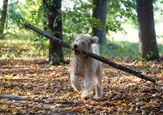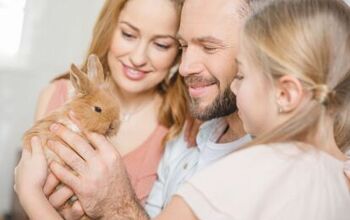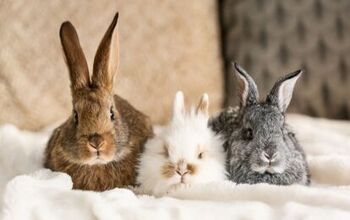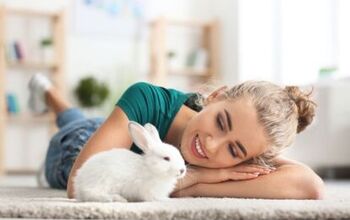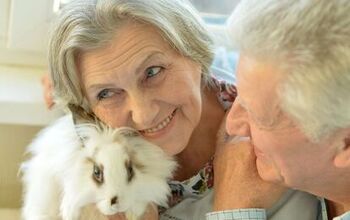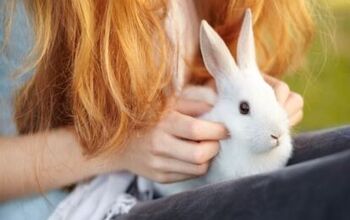Related articles
Best Rabbits for Families
No family is ever truly complete without a loving pet. These are often cats and dogs, but rabbits are a very popular choice as well. There are plenty of good reasons why rabbits remain one of the most sought-after pets – they are intelligent, fun, energetic, and affectionate. Not to mention ridiculously cute! All of this makes them ideal for families, where they can be adored by both kids and their parents. Of course, there are numerous unique rabbit breeds to choose from, and while they all make great pets, not all of them are ideal for a family setting. Some are skittish, some nippy, and others are too docile to fit in with a busy family. But there are those breeds whose unique traits make them perfect for any family, be they large or small. We’ve handpicked 10 breeds that are considered to be the best rabbits for families – you can’t help but fall in love with any of these cute bunnies!
10 Best Rabbits for Beginners
If you're thinking about getting a pet rabbit but you’re not sure where to start, you should first consider which breed would be the best match for your lifestyle and preferences. Some bunnies are too big to be kept in an apartment, others are a bit too high-maintenance for a first-time owner, and some have a personality that won’t click with yours. That’s why it’s important to do your research and make sure that you’ll be able to properly care for the rabbit you pick and that you’ll enjoy their quirks and unique traits as well.To help you find the right companion for you, we’ve rounded up the 10 best rabbits for beginners, whose traits make them perfect for first-time owners. These rabbit breeds are relatively low-maintenance, tend to be friendly and sociable, intelligent and easy to train, so even a complete beginner could manage to train and socialize them with a bit of patience and effort.
10 Best Rabbits for Apartments
When you live in an apartment and want to keep a pet, your options are often limited – not all types of pets are allowed in an apartment, and even when they are, the living environment might not be best suited for their needs. Luckily, that’s not the case for most rabbits! Generally small, well accustomed to life indoors, and quiet enough not to disturb your close neighbors, rabbits make great apartment pets. However, not all breeds of rabbits are the same – some might thrive in a farm-like setting and others get depressed when cooped up for long, so apartments tend to be a no-go for these bunnies. However, there are plenty more that won’t mind being your roommate – these are the 10 best rabbits for apartments, based on their size, personality, and requirements.
Best Rabbits for Seniors
Sharing your golden years with a pet is so rewarding: you have someone to care for, a companion to spend time with, and a sweet, affectionate friend to shower you with love. You might be wondering which pet is the best for seniors – a cat, a dog, or maybe a small animal? Rabbits make a wonderful choice for seniors, for many reasons. They are fairly easy to care for, they are not high maintenance in terms of activity and energy levels, and will fit in great with a slower pace of life that most seniors have. If you’re looking for a pet rabbit to keep you company in your retirement days, or you want to surprise a senior loved one with a fluffy companion, read on – here are the 10 best rabbits for seniors.
Top 10 Best Rabbits for 4H
Participating in 4-H clubs and programs can be an experience that will be cherished for life – especially when a child gains a pet best friend thanks to it. One of many programs that 4-H has is the so-called rabbit project, which is supposed to provide experience with “the selection, feeding, husbandry, and exhibiting of rabbits” to young people. There are various rabbit projects within the 4-H, including breeding, pet, and market projects, but we’ll focus on the best rabbits for 4-H programs that are meant for raising pet rabbits.While bunnies might seem like an easy animal to care for, that might be misleading – rabbits require care, love, and attention as much as any other pet. Even within 4-H guidelines, it is emphasized that the bunnies that are raised for the project should be well taken care of, or the so-called five freedoms rule: freedom from hunger and thirst, from discomfort, from pain, injury or disease, from fear and distress, and freedom to express normal behavior. With that being said, the 4-H rabbit program can be an excellent way to introduce your kid to the responsibility of taking care of a pet. What starts off as a project, can become a beautiful friendship – but only if your child is serious about keeping the rabbit and providing them appropriate care. When it comes to the choice of rabbit breed for 4-H projects, any of the 50 rabbit breeds officially recognized by ARBA are accepted. Here is our choice of the 10 best rabbits for 4-H in terms of ease of care, personality, and showmanship potential.Top 10 Best Rabbits for 4H
Elephants Might Use Unique Names For Each Other, Just Like Us Humans
It seems that humans are not the only ones in the animal world to use personal names – according to a revolutionary new study, African elephants also refer to one another through unique sounds. The study, published in Nature Ecology & Evolution, reveals that elephants can hear their own names over long distances, across the African savanna, and that they speak to one another through a series of low rumbles. The scientific team also reveals that elephants can learn to recognize and call to their mates using their “personal” names, instead of just basic sounds.“Here we present evidence that wild African elephants address one another with individually specific calls, probably without relying on imitation of the receiver,” the study reads.In order to achieve these impressive results, the study used machine learning to demonstrate that the receiver of a call could be predicted from the call’s acoustic structure, regardless of how similar the call was to the receiver’s vocalizations.A herd of African elephants was followed in jeeps in the wild, at Kenya’s Samburu National Reserve and Amboseli National Park, in order to closely observe their behavior and how they call out, and who responds."We've had several incidents where we've been with these elephants and the matriarch of the family will give a call, and everyone in the family will answer,” co-author and Colorado State University ecologist George Wittemyer, said to ITV News. "Then several seconds later, she'll give seemingly a very similar call and nobody in the family would answer except one individual."Researchers then played these recordings of the individual names to elephants and learned that the animals responded more enthusiastically by flapping their ears and lifting their trunks, whenever they heard their own names. “Just like humans, elephants use names, but probably don’t use names in the majority of utterances, so we wouldn’t expect 100%,” study author and Cornell University biologist Mickey Pardo added. Scientists say that animals with complex social structures and close-knit families are more likely to use personal names, as it helps them to be reunited if separated. “If you’re looking after a large family, you’ve got to be able to say, ‘Hey, Virginia, get over here!’ ” Duke University ecologist Stuart Pimm said.“Elephants are incredibly social, always talking and touching each other - this naming is probably one of the things that underpins their ability to communicate to individuals,” Wittemyer added, “We just cracked open the door a bit to the elephant mind.”
World's Tallest Dog, Kevin, Dies Unexpectedly at Age Three
The world’s tallest male dog, Kevin, has died unexpectedly just days after his record-breaking accomplishment was announced to the world. According to a statement issued by the Guinness World Records, the gentle giant, who was only three years old, passed away after falling ill and undergoing an unexpected surgery. In March, Guinness World Records officially recognized Kevin as the world’s tallest living male dog.“Our whole family is devastated about Kevin. He was just the best giant boy,” said Kevin’s owner, Tracy Wolfe, in a statement. “We are so glad that he was able to break the record and have that light on him. He absolutely adored the attention. I wish these giant breeds, and all dogs, could live longer than they do. It’s never enough time.” Kevin secured his record after measuring 3ft 2in (0.97 meters) tall from his feet to his withers, or the ridge between the shoulder blades. However, when he stood up on his hind legs, Kevin was around 7ft tall, which is a foot taller than the average American man.The gentle giant got the title of the world’s tallest living male dog after the crown remained unclaimed for six months following the death of another American Great Dane. The previous record holder, Zeus, was 3ft 5.18in (1.046 meters) tall. Zeus had his right front leg amputated while battling bone cancer. Like Kevin, Zeus was only three years old when he suddenly died after developing a severe case of pneumonia. Just a few weeks ago, Guinness World Records published an interview with Kevin’s family, about how their pooch would act like he was clueless about his size. Wolfes described Kevin as a “gentle giant” who loved nothing more than snoozing on the sofa.“Kevin’s favorite activity is probably taking naps. Holding the couch down is his favorite pastime, I think,” said Tracy Wolfe. “Kevin is funny, and he is super duper friendly. In fact, overly friendly. You don’t want to keep your mouth open too much when he’s around,” she added. Named after the leading character in the Home Alone film series, Kevin was petrified of the vacuum cleaner. “He won’t let it come within six feet of him,” said Tracy adding that he would jump and run away from it. Many cats and dogs are terrified of vacuum cleaners because of the loud noises they produce. But Kevin’s fear of the vacuum cleaner was comical, considering how he towered over most things around him and was often mistaken for a small horse. The Wolfes welcomed Kevin into their family when he was just a puppy and couldn’t imagine that he would grow so big as to claim the title of the world’s tallest dog. The pooch was close to all members of the family but had developed a special bond with the Wolfes’ son Alexander, who took him to training classes.Despite his imposing size, Kevin was a scaredy cat. The first time Alexandar took Kevin to a training class at a youth development and monitoring organization, the pooch got so afraid that he soiled himself in the middle of the class. Kevin attracted attention wherever he went and he enjoyed every second of it. Sadly his stint as the world’s tallest living male dog was unexpectedly cut short. A spokesperson for the Guinness World Records said: “We are deeply saddened to learn that Kevin suddenly passed away after unexpected health complications. Tracy and the team at the vet clinic she works in did everything they could to save Kevin after he became ill. Our thoughts and support are with the Wolfe family as they navigate this difficult time.”Join the PetGuide community. Get the latest pet news and product recommendations by subscribing to our newsletter here.
Is Your Cat Ready to Chow Down on Carrots and Cukes?
Research is showing your pet may be healthier if they ditch the meat and opt for veggies.
Scientists Developing AI Technology To Decipher Your Dog’s Barking
There is no dog owner out there who doesn’t wish to understand their pet’s bark! And now that artificial intelligence is evolving and expanding with each new day, it seems that this seemingly impossible feat can now become a reality.A research team at the University of Michigan is now studying how exactly artificial intelligence can be used to help understand the way dogs communicate. The scientists are developing special AI tools that will ultimately help understand whether a dog’s bark is aggressive, or shows playful intentions. And that is not all – AI will help gather crucial information from the bark, such as the breed, age, and sex of the dog. “By using speech processing models initially trained on human speech, our research opens a new window into how we can leverage what we built so far in speech processing to start understanding the nuances of dog barks,” said Rada Mihalcea, director of the University of Michigan’s AI laboratory.Throughout the course of the study, the team studied vocalizations from 74 different dogs, all in various contexts. They quickly realized that AI models that were originally trained on human speech could now be a great starting point to help train new AI systems made specifically to understand animal communication.“There is so much we don’t yet know about the animals that share this world with us,” said Mihalcea. “Advances in AI can be used to revolutionize our understanding of animal communication, and our findings suggest that we may not have to start from scratch.”Mihalcea also adds that all their findings indicate that “the sounds and patterns originating from human speech can form the basis for examining and comprehending the acoustic patterns of other sounds, including animal vocalizations”.But even so, using AI to analyze dog communication is hindered, as there is still a lack of data available publicly.“Animal vocalizations are logistically much harder to solicit and record,” said Artem Abzaliev, lead author of the study. “They must be passively recorded in the wild or, in the case of domestic pets, with the permission of owners.”Besides this, scientists were also able to reuse a model that analyzed human speech. This helped them to “tap into” major voice-enabled technologies that can actually recognize spoken words and those speaking them.“These models are able to learn and encode the incredibly complex patterns of human language and speech,” Abzaliev adds. “We wanted to see if we could leverage this ability to discern and interpret dog barks.”What is more, according to the study the research will also have major implications for animal welfare. If we can understand dog vocalizations, it can help us respond better to the needs of our pets.
Ce n'est pas possible! French Actor Wants To be Buried with Pet Dog
Famed film actor Alain Delon's death triggers uproar over a special request.
Backyard Airbnbs Give Dog Owners A Private Leash-Free Space to Play
Hourly backyard rentals provide a perfect alternative to the crowded leash-free environment.
Two Pet Food Recalls Spark Fear of Bacterial Infections
This week, the Food and Drug Administration (FDA) issued two separate pet food recalls over fears of bacterial contamination that could cause health issues in pets and, in some cases, death.The first recall notice involves pet food for cats and dogs, and the second notice involves pet food for hedgehogs.A popular online pet food company, Viva Raw LLC of Hillsborough, North Carolina, has voluntarily recalled five of its cat and dog foods over the fears that the products may be contaminated with Listeria monocytogenes. According to an announcement on the FDA website, the recalled products include Viva Turkey for Dogs Ground, Viva Turkey for Dogs Chunked, Viva Turkey for Cats, Viva Pure Turkey, and Viva Beef & Turkey for Puppies. All of the recalled products were manufactured under Lot 21244. The products involved in the recall were packed in clear packaging and shipped as frozen, one-pound bricks. The expiration date wasn’t listed on any of the packaging. The recalled cat and dog food was distributed to customers in all 50 states, including the Columbia district. Listeria was discovered in the food after the FDA conducted sample testing on Viva Turkey for Dogs. All pet food products from the same lot should have been destroyed, but the company claims some items were ‘inadvertently released from the warehouse’ to customers. According to the FDA press release: “Viva Raw is notifying all customers who were shipped any Turkey or Beef & Turkey for Puppies products between May 16th and June 28th, 2024. No illnesses related to this lot have been reported to date.” Listeria monocytogenes is a bacteria that can cause Listeriosis in humans. Listeriosis is a serious infection that causes vomiting, fever, and diarrhea, among other symptoms. Pregnant women, young children, and old and sick people are at most risk of developing severe complications. In cats and dogs, this bacteria can cause diarrhea, anorexia, and fever. Some animals can also experience depression, miscarriage, and death.In addition to becoming sick, pets who consume the contaminated food can also become carriers, spreading listeria through their saliva and feces and infecting people and animals they come in contact with.In its notice, the FDA advises owners not to feed these contaminated products to pets. Also, you shouldn’t touch these products with your bare hands. Use gloves or paper towels to dump the product in a sealed bag and then disinfect all the surfaces that have come into contact with it.The second recall involves various lots of Sun Seed Vita Prima Hedgehog Food and Vitakraft Vita Smart Hedgehog Food. The Vitakraft Sun Seed Inc. of Wisconsin, Ohio, has voluntarily recalled some lots of various hedgehog foods, as they may be contaminated with Salmonella.According to the notice, the recalled products were distributed in many states, including Arizona, California, Georgia, Florida, Indiana, Illinois, Kentucky, Michigan, Massachusetts, Missouri, Minnesota, Nevada, North Carolina, New York, New Jersey, Ohio, Pennsylvania, South Carolina, Texas, Tennessee, Virginia, and Wisconsin.Salmonella is a bacteria that can cause serious infections in humans and animals. In humans, the most common symptoms of Salmonella are nausea, vomiting, diarrhea or bloody diarrhea, fever, and abdominal cramping. However, this bacteria can cause even more serious issues in people, including arthritis, endocarditis, arterial infections, and more. Pets suffering from a Salmonella infection can experience fever, diarrhea, bloody diarrhea, decreased appetite, abdominal pain, and vomiting. Some infected animals don’t exhibit any symptoms, but can be carriers of Salmonella and spread it to other people and pets. Join the PetGuide community. Get the latest pet news and product recommendations by subscribing to our newsletter here.
FIP Treatment Now Available for Cats
As of June 1, 2024, pet parents can get the FIP treatment they need for their cats, but there is some confusion about this. Feline infectious peritonitis (FIP) is a fatal condition, but pet parents have been using a drug, GS-441524, to cure their cats (though the drug is not always effective in all cases). Despite the success of the treatment, the problem has been that the drug was only available on the black market, so people would access it with the help of groups on social media since vets weren’t able to prescribe it.
Why Do Dogs Lick Their Wounds?
Do they know something we don't? Should we be ditching the antibiotics?
Dogs Can Smell When You’re Stressed
Researchers have discovered that dogs can smell human stress and it can affect the way they make decisions. The study was conducted in the United Kingdom, and helps shed more light on how dogs can be impacted by the emotions experienced by people.
How Do I Introduce My Dog to Agility at Home?
Have you ever watched a dog on social media zoom through a tunnel or weave through poles with joy and happiness on their face? If so, you may be considering getting involved in dog agility.This exciting sport is a great way to bond with your pup while providing both physical and mental stimulation. But where do you begin? Many dog parents who are considering getting involved in agility quickly become overwhelmed with the costs and commitment required to compete in this sport professionally.In this article, I will guide you through everything you need to know to introduce your dog to agility in the comfort of your own home. From building simple obstacles to mastering basic commands, you can start exploring this sport with your best friend today.Can All Dogs Do Agility? If you have been watching dog agility events, you may have noticed that a few breeds often dominate the sport. Many of the top competitors are border collies, Australian shepherds, and golden retrievers. However, if you watch long enough, you will notice that even the professional competitors are enjoyed by a wide variety of different dogs, including many breeds and sizes. Whether your dog is a purebred border collie or a mixed-breed rescue, they can take part in (and love) agility. How Do You Know if Your Dog Will Be Good at Agility? While any dog can participate in agility, a few key traits distinguish casual hobby athletes from the top dogs in professional agility competitions. For dog parents who want to use agility activities as a fun bonding experience at home, top performance may not matter. However, if you are interested in getting into the sport professionally, you want to look for the following traits: Active and high-energy Good coordinationHighly trainable Ability to concentrate despite distractionsConfident Easily motivated Good health
Gene Mutation Raises Risk of Side Effects from Parasite Preventatives
According to findings from a recent study, over half a million cats in the U.S. should not be given certain parasite preventatives because they are at risk of serious adverse reactions. Pet parents who plan to use or currently use these products on their cats should inform themselves so they can make the right decisions for their pets’ health.
Should You Bathe Your Cat?
We’ve all seen those old-school cartoons in which cats absolutely hate water or taking baths. Is there truth to that myth? Should you even question bathing your feline friend? Well, believe it or not, bathing a cat is a topic of much debate amongst owners. Some believe that it is paramount for maintaining their cat’s hygiene, while others think it is stressful and unnecessary. But what is the final word? There are several factors to consider, so let’s delve into it.Cats – and all felines in general – are well known for their cleanliness. They spend a significant amount of time grooming themselves and will use their tongues to remove dirt, parasites, and all that loose fur. This is their natural behavior and cemented their reputation as clean and orderly animals. Besides this, the behavior ensures that their coat remains clean and it reduces the need for frequent baths. And, in fact, regular grooming is sufficient to maintain a clean and healthy coat – for most cats. And while many cats never really need a bath, there are situations where it might be necessary. For example, if your cat has gotten into something greasy, sticky, or even toxic, a bath might be the only possible way to remove that dirt. Similarly, if your kitty has a skin condition, your vet could recommend medicated baths as part of the treatment.What is more, certain long-haired felines, such as Persian cats, could also benefit from an occasional bath. This will prevent matting and keep their fur in good condition. It should also be noted that cats with certain health issues, such as arthritis and obesity, might have problems grooming themselves. In such cases, you need to help them stay clean with a bath. If you decide that your cat needs a bath, it is important to do it safely and calmly. Cats are not usually fond of water and are often willful. So the experience could be a bit stressful for them. In order to minimize that stress, you should choose a quiet time when your cat is calm and relaxed. Use lukewarm water and a shampoo designed specifically for cats. Remember that human products can be too harsh for a cat’s sensitive skin.
